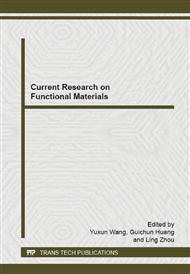[1]
X. Zhang, Y. Wang, Y. You, H. Meng, J. Zhang, X. Xu, Preparation, performance and adsorption activity of TiO2 nanoparticles entrapped PVDF hybrid membranes[J], Appl. Surf. Sci. 263 (2012) 660-665.
DOI: 10.1016/j.apsusc.2012.09.131
Google Scholar
[2]
L. Yu, Z. Xu, H. Shen, H. Yang, Preparation and characterization of PVDF-SiO2 composite hollow fiber UF membrane by sol–gel method[J], J. Membr. Sci. 337 (2009) 257-265.
DOI: 10.1016/j.memsci.2009.03.054
Google Scholar
[3]
N.A.A. Hamid, A.F. Ismail, T. Matsuura, A.W. Zularisam, W.J. Lau, E. Yuliwati, M.S. Abdullah, Morphological and separation performance study of polysulfone/titanium dioxide(PSF/TiO2) ultrafiltration membranes for humic acid removal[J], Desalination. 273 (2011).
DOI: 10.1016/j.desal.2010.12.052
Google Scholar
[4]
S.C. Pesek, W.J. Koros, Aqueous quenched asymmetric polysulfone hollow fibers prepared by dry/wet phase separation[J], J. Membr. Sci. 88 (1994) 1-19.
DOI: 10.1016/0376-7388(93)e0150-i
Google Scholar
[5]
T. He, L.A.M. Versteeg, M.H.V. Mulder, M. Wessling, Composite hollow fiber membranes for organic solvent-based liquid–liquid extraction[J], J. Membr. Sci. 234 (2004) 1–10.
DOI: 10.1016/j.memsci.2003.12.015
Google Scholar
[6]
A. Idris, A.F. Ismail, M.Y. Noordin, S.J. Shilton, Optimization of cellulose acetate hollow fiber reverse osmosis membrane production using Tagushi method[J], J. Membr. Sci. 205 (2002) 223–237.
DOI: 10.1016/s0376-7388(02)00116-3
Google Scholar
[7]
M. Khayet, The effects of air gap length on the internal and external morphology of hollowfiber membranes[J], Chem. Eng. Sci. 58 (2003) 3091–3104.
DOI: 10.1016/s0009-2509(03)00186-6
Google Scholar
[8]
Q. Yang, T.S. Chung, Y.W. Santoso, Tailoring pore size and pore size distribution of kidney dialysis hollowfiber membranes via dual-bath coagulation approach[J], J. Membr. Sci. 290 (2007) 153–163.
DOI: 10.1016/j.memsci.2006.12.036
Google Scholar
[9]
K.Y. Wang, T. Matsuura, T.S. Chung, W.F. Guo, The effects of flow angle and shear rate with the spinneret on the separation performance of poly(ethersulfone) (PES) ultrafiltration hollowfiber membranes[J], J. Membr. Sci. 240 (2004) 67–79.
DOI: 10.1016/j.memsci.2004.04.012
Google Scholar
[10]
M. Khayet, C.Y. Feng, K.C. Khulbe, T. Matsuura, Study on the effect of a non-solvent additive on the morphology and performance of ultrafiltration hollow-fiber membranes[J], Desalination 148 (2002) 31–37.
DOI: 10.1016/s0011-9164(02)00724-5
Google Scholar
[11]
J. Qin, T.S. Chung, Effect of dope flow rate on the morphology, separation performance, thermal and mechanical properties of ultrafiltration hollow fiber membranes[J], J. Membr. Sci. 157 (1999) 35–51.
DOI: 10.1016/s0376-7388(98)00361-5
Google Scholar
[12]
A.F. Ismail, M.I. Mustaffar, R.M. Illias, M.S. Abdullah, Effect of dope extrusion rate on morphology and performance of hollow fibers membrane for ultrafiltation[J], Sep. Purf. Technol. 49 (2006) 10–19.
DOI: 10.1016/j.seppur.2005.08.001
Google Scholar
[13]
S. Rafiq, Z. Mana, A. Maulud, N. Muhammad, S. Maitra, Separation of CO2 from CH4 using polysulfone/polyimide silica nanocomposite membranes[J], Separation and Purification, Technology. 90 (2012)162-172.
DOI: 10.1016/j.seppur.2012.02.031
Google Scholar
[14]
V. Vatanpour, S. S. Madaeni, A. R. Khataee, et al, TiO2 embedded mixed matrix PES nanocomposite membranes: Influence of different sizes and types of nanoparticles on antifouling and performance[J], Desalination. 292 (2012) 19–29.
DOI: 10.1016/j.desal.2012.02.006
Google Scholar
[15]
M. F. A. Wahab, A. F. Ismail, S. J. Shilton, Studies on gas permeation performance of asymmetric polysulfone hollow fiber mixed matrix membranes using nanosized fumed silica as fillers[J], Sep. Purif. Technol. 86 (2012) 41–48.
DOI: 10.1016/j.seppur.2011.10.018
Google Scholar
[16]
G. J. Dahe, R. S. Teotia, J. R. Bellare, The role of zeolite nanoparticles additive on morphology, mechanical properties and performance of polysulfone hollow fiber membranes[J], Chem. Eng. J. 197 (2012) 398–406.
DOI: 10.1016/j.cej.2012.05.037
Google Scholar
[17]
B. Topuz, L. Yilmaz, H. Kalipcilar, Development of alumina supported ternary mixed matrix membranes for separation of H2/light-alkane mixtures[J], J. Membr. Sci. 415–416 (2012) 725–733.
DOI: 10.1016/j.memsci.2012.05.060
Google Scholar
[18]
S. M. Momeni, M. Pakizeh, Preparation, characterization and gas permeation study of PSf/MgO nanocomposite membrane[J], Braz. J. Chem. Eng. 30 (2013) 589–597.
DOI: 10.1590/s0104-66322013000300016
Google Scholar
[19]
Abhinav K. Nair, Arun M. Isloor, Rajesha Kumar, A.F. Ismail, Antifouling and performance enhancement of polysulfone ultrafiltration membranes using CaCO3 nanoparticles[J], Desalination. 322 (2013) 69–75.
DOI: 10.1016/j.desal.2013.04.031
Google Scholar
[20]
S. S. Ozdemir, M. G. Buonomenna, E. Drioli, Catalytic polymeric membranes: Preparation and application[J], Appl. Catal. A-Gen. 307 (2006) 167-183.
DOI: 10.1016/j.apcata.2006.03.058
Google Scholar
[21]
S. Long, A.Q. Zhang, H.F. Liu, L. Li, L.Q. Ding, Fabrication of a Pt Nano-cluster/Photosensitive Polyimide Hybrid Membrane Reactor and Its Partial Hydrogenation of Benzene[J], Chin. J. Catal., 30 (2009) 276–278.
DOI: 10.1016/s1872-2067(08)60100-x
Google Scholar
[22]
H. Zhai, A.Q. Zhang, L. Li, S. Long, Partial Hydrogenation of Benzene Catalyzed by Pt/N- n -Propyl Chitosan Hybrid Membrane[J], J. Appl. Polym. Sci. 123 (2012) 2140–2146.
DOI: 10.1002/app.34720
Google Scholar
[23]
A.Q. Zhang, M. Li, W. C. Ou, et al, Fabrication of a Ru nano-cluster/photosensitive polyimide hybrid membrane reactor and its partial hydrogenation of benzene[J], Chin. J. South-Central University Nationalities(Nat. Sci. Edition). 28(2) (2009).
DOI: 10.1016/s1872-2067(08)60100-x
Google Scholar
[24]
S. H. Joo, J. Y. Park, J. R. Renzas, et al, Size Effect of Ruthenium Nanoparticles in Catalytic Carbon Monoxide Oxidation[J], Nano Letters. 10(7) (2010) 2709-2713.
DOI: 10.1021/nl101700j
Google Scholar
[25]
H.F. Liu, H.J. Niu, J.G. Gao, Synthesis of polymer-stabilized ruthenium colloids by low boiling point alcohol reduction [J], Chinese. J. Polym. Sci. 21(1) (2003) 1-4.
Google Scholar
[26]
J. B. Ning, J. Xu, J. Liu, et al, Selective hydrogenation of benzene to cyclohexene over colloidal ruthenium catalyst stabilized by silica[J], Catal. Lett. 109 (2006) 175.
DOI: 10.1007/s10562-006-0075-1
Google Scholar
[27]
M. Amirilargani, E. Saljoughi, T. Mohammadi, Effects of Tween 80 concentration as a surfactant additive on morphology and permeability of flat sheet polyethersulfone (PES) membranes[J], Desalination. 249 (2009) 837–842.
DOI: 10.1016/j.desal.2009.01.041
Google Scholar
[28]
J.N. Shen, H.M. Ruan, L.G. Wu, et al, Preparation and characterization of PES–SiO2 organic–inorganic composite ultrafiltration membrane for raw water pretreatment[J], Chem. Eng. J. 168 (2011) 1272–1278.
DOI: 10.1016/j.cej.2011.02.039
Google Scholar
[29]
Xiao Y, Chung T S, Guan H M, et al. Synthesis, cross-linking and carbonization of co-polyimides containing internal acetylene units for gas separation[J], J. Membr. Sci. 2007 (302) 254-64.
DOI: 10.1016/j.memsci.2007.06.068
Google Scholar


